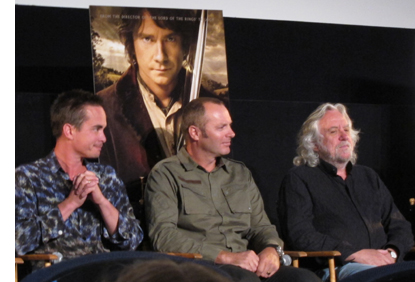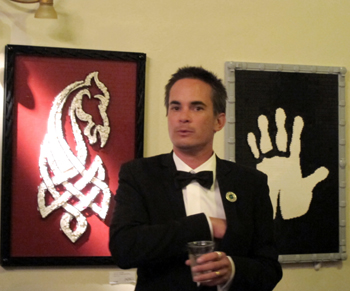Last week, all fans of TheOneRing.net were focused on the approach of “The One Expected Party.” But there was another event involving some of the Oscar-nominated members of The Hobbit production team. On Saturday, February 23, the  Egyptian Theatre on Hollywood Boulevard (just down the street from the Dolby Theatre) was the venue for “The Art of Production Design,” jointly sponsored by the Art Directors Guild, the Set Decorators Society of America, and the American Cinematheque.
Egyptian Theatre on Hollywood Boulevard (just down the street from the Dolby Theatre) was the venue for “The Art of Production Design,” jointly sponsored by the Art Directors Guild, the Set Decorators Society of America, and the American Cinematheque.
The panel of guests was made up of the production designers for Lincoln, Anna Karenina, Life of Pi, and Les Misérables, as well as The Hobbit: An Unexpected Journey. Dan Hennah was there as production designer (at the right in the photo), along with Ra Vincent (left) and Simon Bright (center), the set decorators.
With that much talent present, the time allotted to each film was all too short. Dan Hennah assured the audience that the designs for The Hobbit were not just a return to The Lord of the Rings. There were new challenges involved in what he called a “long and relentless journey.” A great deal of pre-production had taken place during the period when Guillermo del Toro was on board as director. Once Peter Jackson took over, everything was revisited.
Hennah answered a question from the audience concerning where conceptual design, done for The Hobbit by illustrators John Howe and Alan Lee, ends and production design begins. He responded that conceptual design involves creating the environments as a whole, as if they were real places. Once those designs are finalized, “The production design kicks in in terms of what takes place in the parts of that set.”
The sets were drawn digitally and then built as 3D models that went to the pre-viz department. Howe and Lee worked at Weta Digital rather than in the art department, as did one assistant art director. Among their several tasks, Vincent and Bright both consulted on the color grading. There were four active stages at the Stone Street Studios, and the pair also handled the logistic for scheduling construction of Hennah’s sets and then arranging for them to be taken down overnight.
Hennah spoke of the design of the huge Goblin Town set. He conceived it as having been built within a great diagonal rift inside the mountain caused by an earthquake. The Goblins being thieves, they constructed the buildings and bridges out of random stolen items like carts. The layout of the Dwarves kingdom within the Lonely Mountain derived from the idea that the space expanded randomly as the workers removed stone to follow veins of gold.
On Sunday night, the Oscar for the Production Design category went to Rick Carter and his set decorator Jim Erickson for Lincoln, a film that Hennah graciously said deserved the award. Many fans, of course, are hoping that the third part of The Hobbit will repeat the success of The Return of the King, scooping up Oscars earned by the entire trilogy.
Ra Vincent at “The One Expected Party,” wearing the good-luck pin created for the nominees by TheOneRing.net



